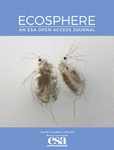Please find all scientific publications of IGB under > scientific publications
For more detailed information please refer to our > library catalogue
1 - 10 of 611 items
April 2025
Biogeochemistry. - 168(2025), Art. 40
Biogenic polyphosphate as relevant regulator of seasonal phosphate storage in surface sediments of stratified eutrophic lakes
Lucas Schröder; Peter Schmieder; Michael Hupfer
Using nuclear magnetic resonance spectroscopy, the authors studied the polyphosphate seasonality in the topmost sediment layer of three stratified lakes with prolonged anoxic periods during summer stratification. Polyphosphate acted as a temporary phosphorus storage, formed at the beginning of the summer stratification under oxic conditions and released time delayed under anoxic conditions.

April 2025
Trends in Ecology and Evolution. - 40(2025)4, 385-394
Understanding biological invasions through the lens of environmental niches
Chunlong Liu; Céline Bellard; Jonathan M. Jeschke
April 2025
Oikos. - XX(2025)X, Art. e11029
Longer durability of host–parasite interaction increases host density
Patch Thongthaisong; Minoru Kasada; Hans-Peter Grossart; Sabine Wollrab
April 2025
Research ideas and outcomes. - 11(2025), Art. e140548
Hypothesis Description: Darwin’s Naturalisation Hypothesis
Florencia A. Yannelli; Wayne Dawson; Mark van Kleunen; Jonathan M. Jeschke; Tina Heger

March 2025
Science. - 387(2025)6739, 1181-1186
Environmental effects of the Kakhovka Dam destruction by warfare in Ukraine
O. Shumilova; A. Sukhodolov; N. Osadcha; A. Oreshchenko; G. Constantinescu; S. Afanasyev; M. Koken; V. Osadchyi; B. Rhoads; K. Tockner; M. T. Monaghan; B. Schröder; J. Nabyvanets; C. Wolter; O. Lietytska; J. van de Koppel; N. Magas; S. C. Jähnig; V. Lakisova; G. Trokhymenko; M. Venohr; V. Komorin; S. Stepanenko; V. Khilchevskyi; S. Domisch; M. Blettler; P. Gleick; L. De Meester; H.-P. Grossart

March 2025
Ecological monographs. - 95(2025)1, Art. e70010
Functional macroinvertebrate diversity stabilizes decomposition among leaf litter resources across a river network
Rubén del Campo; Rosetta C. Blackman; Jan Martini; Thomas Fuß; Lukas Thuile Bistarelli; Mark O. Gessner; Florian Altermatt; Gabriel Singer

March 2025
Ecosphere. - 16(2025)3, Art. 70205
Too much and not enough data: Challenges and solutions for generating information in freshwater research and monitoring
Adrianne P. Smits; Ed K. Hall; Bridget R. Deemer; Facundo Scordo; Carolina C. Barbosa; Stephanie M. Carlson; Kaelin Cawley; Hans-Peter Grossart; Patrick Kelly; Stefano Mammola; Matthew R. Pintar; Caleb J. Robbins; Albert Ruhi; Mattia Saccò
March 2025
Water Research. - XX(2025)X, Art. 123553
Anthropogenic imprint on riverine plasmidome diversity and proliferation of antibiotic resistance genes following pollution and urbanization
Kenia Barrantes-Jiménez; Franck Lejzerowicz; Tam Tran; Melany Calderón-Osorno; Luis Rivera-Montero; César Rodríguez-Sánchez; Odd-Gunnar Wikmark; Alexander Eiler; Hans-Peter Grossart; María Arias-Andrés; Keilor Rojas-Jiménez
March 2025
Ecosystems. - 28(2025), Art. 23
Flexibility in Aquatic Food Web Interactions: Linking Scales and Approaches
Ellen van Velzen; Sabine Wollrab; Onur Kerimoglu; Ursula Gaedke; Hans-Peter Grossart; Minoru Kasada; Helena C. L. Klip; Stefanie Moorthi; Tom Shatwell; Patch Thongthaisong; A. E. Friederike Prowe
March 2025
Biological Conservation. - 305(2025), Art. 111092
A systematic map of hydropower impacts on megafauna at the land-water interface
Vassil Y. Altanov; Sonja C. Jähnig; Fengzhi He






